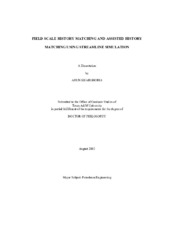| dc.description.abstract | In this study, we apply the streamline-based production data integration method to condition a multimillion cell geologic model to historical production response for a giant Saudi Arabian reservoir. The field has been under peripheral water injection with 16 injectors and 70 producers. There is also a strong aquifer influx into the field. A total of 30 years of production history with detailed rate, infill well and re-perforation schedule were incorporated via multiple pressure updates during streamline simulation. Also, gravity and compressibility effects were included to account for water slumping and aquifer support. To our knowledge, this is the first and the largest such application of production data integration to geologic models accounting for realistic field conditions. We have developed novel techniques to analytically compute the sensitivities of the production response in the presence of gravity and changing field conditions. This makes our method computationally extremely efficient. The field application takes less than 6 hours to run on a PC.
The geologic model derived after conditioning to production response was validated using field surveillance data. In particular, the flood front movement, the aquifer encroachment and bypassed oil locations obtained from the geologic model was found to be consistent with field observations. Finally, an examination of the permeability changes during production data integration revealed that most of these changes were aligned along the facies distribution, particularly the 'good' facies distribution with no resulting loss in geologic realism.
We also propose a novel assisted history matching procedure for finite difference simulators using streamline derived sensitivity calculations. Unlike existing assisted history matching techniques where the user is required to manually adjust the parameters, this procedure combines the rigor of finite difference models and efficiencies of streamline simulators to perform history matching. Finite difference simulator is used to solve for pressure, flux and saturations which, in turn, are used as input for the streamline simulator for estimating the parameter sensitivities analytically. The streamline derived sensitivities are then used to update the reservoir model. The updated model is then used in the finite difference simulator in an iterative mode until a significant satisfactory history match is obtained.
The assisted history matching procedure has been tested for both synthetic and field examples. The results show a significant speed-up in history matching using conventional finite difference simulators. | en |


